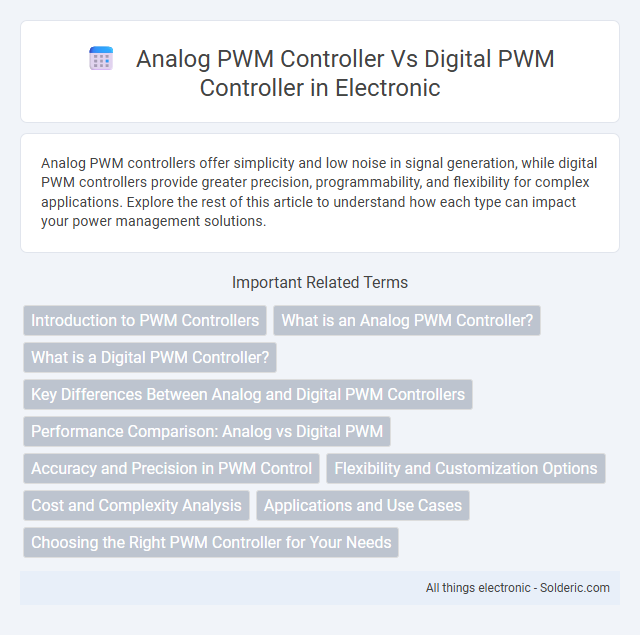Analog PWM controllers offer simplicity and low noise in signal generation, while digital PWM controllers provide greater precision, programmability, and flexibility for complex applications. Explore the rest of this article to understand how each type can impact your power management solutions.
Comparison Table
| Feature | Analog PWM Controller | Digital PWM Controller |
|---|---|---|
| Control Method | Continuous analog signals | Discrete digital signals (microcontroller/FPGA based) |
| Precision | Lower, affected by component tolerances | High, programmable and consistent |
| Flexibility | Limited, fixed function | Highly flexible with software adjustments |
| Complexity | Simple circuitry | Complex, requires programming and digital design |
| Cost | Generally lower | Higher initial cost, but cost-effective for complex tasks |
| Response Time | Faster response due to analog nature | Slower, limited by processing speed |
| Noise Immunity | Lower, sensitive to analog noise | Higher, robust against noise |
| Integration | Discrete components | Highly integrable in SoCs and MCUs |
| Applications | Simple motor control, lighting dimmers | Advanced motor drives, power converters, embedded systems |
Introduction to PWM Controllers
PWM controllers regulate voltage and current in electronic circuits by adjusting pulse width modulation signals. Analog PWM controllers use continuous voltage signals for modulation, offering simplicity and faster transient response in applications like motor control and power supplies. Digital PWM controllers utilize microcontrollers or digital logic, providing enhanced precision, programmability, and adaptability for complex and multi-channel systems.
What is an Analog PWM Controller?
An analog PWM controller generates pulse-width modulation signals using continuous analog circuits, typically consisting of comparators, resistors, and capacitors, which regulate duty cycle based on voltage or current feedback. This approach offers simplicity, low cost, and smooth control suitable for applications where precise digital timing is unnecessary. Understanding the fundamental operation of your analog PWM controller helps optimize its performance in power conversion and motor control systems.
What is a Digital PWM Controller?
A Digital PWM controller uses microcontrollers or digital signal processors to generate precise pulse-width modulation signals for controlling power delivery in electronic devices. It offers enhanced accuracy, programmability, and flexibility compared to analog PWM controllers, enabling complex algorithms and real-time adjustments to optimize system performance. Your design benefits from improved efficiency, reduced electromagnetic interference, and easier integration with digital communication interfaces.
Key Differences Between Analog and Digital PWM Controllers
Analog PWM controllers generate continuous control signals through voltage or current variations, providing smooth and simple modulation suited for basic applications. Digital PWM controllers use microcontrollers or digital logic to produce precise, programmable pulses with enhanced flexibility and complex features like adaptive control and fault protection. Choosing between them depends on your specific needs for accuracy, programmability, and system complexity.
Performance Comparison: Analog vs Digital PWM
Analog PWM controllers offer faster response times and lower latency, making them ideal for high-frequency switching applications with minimal signal delay. Digital PWM controllers provide superior flexibility, programmability, and precision through software adjustments, enabling advanced features like adaptive modulation and real-time monitoring. While analog designs excel in simplicity and speed, digital controllers deliver enhanced performance in complex systems requiring dynamic control and integration with microcontrollers.
Accuracy and Precision in PWM Control
Analog PWM controllers offer high-speed response and smooth voltage modulation but may suffer from drift and limited precision due to component tolerances. Digital PWM controllers provide greater accuracy and stability, leveraging microcontroller-based timing and digital feedback algorithms to maintain consistent pulse width and frequency. Enhanced programmability in digital controllers enables precise control adjustments, minimizing errors and improving overall system performance.
Flexibility and Customization Options
Analog PWM controllers offer limited flexibility as their performance depends on fixed hardware components like resistors and capacitors, restricting real-time adjustments and complex modulation schemes. Digital PWM controllers provide enhanced customization through programmable settings and software algorithms, allowing precise control over frequency, duty cycle, and adaptive responses to varying system conditions. This programmability in digital controllers enables seamless integration with microcontrollers and advanced control strategies, improving overall system efficiency and versatility.
Cost and Complexity Analysis
Analog PWM controllers generally offer lower cost and simpler circuitry due to their straightforward design using basic components like comparators and resistors. Digital PWM controllers tend to have higher initial costs and complexity, integrating microcontrollers or DSPs for precise control and programmability, which increases development time and firmware needs. Despite the increased cost, digital controllers provide enhanced flexibility and advanced features such as adaptive switching frequency and real-time monitoring.
Applications and Use Cases
Analog PWM controllers excel in applications requiring simple, cost-effective solutions with fast response times, such as in basic motor speed control, LED dimming, and low-frequency power regulation. Digital PWM controllers offer superior precision, programmability, and adaptability, making them ideal for complex systems like advanced motor drives, renewable energy inverters, and embedded systems requiring real-time control and telemetry. Your choice depends on the need for flexibility and integration with digital systems versus straightforward, reliable analog control.
Choosing the Right PWM Controller for Your Needs
Choosing the right PWM controller depends on the specific application requirements, such as precision, efficiency, and flexibility. Analog PWM controllers offer simplicity and low latency ideal for basic motor control and power regulation, while digital PWM controllers provide advanced features, higher accuracy, and programmability suitable for complex systems, IoT devices, and adaptive environments. Evaluating system demands, cost constraints, and desired control sophistication ensures optimal performance and energy savings with the appropriate PWM technology.
analog PWM controller vs digital PWM controller Infographic

 solderic.com
solderic.com